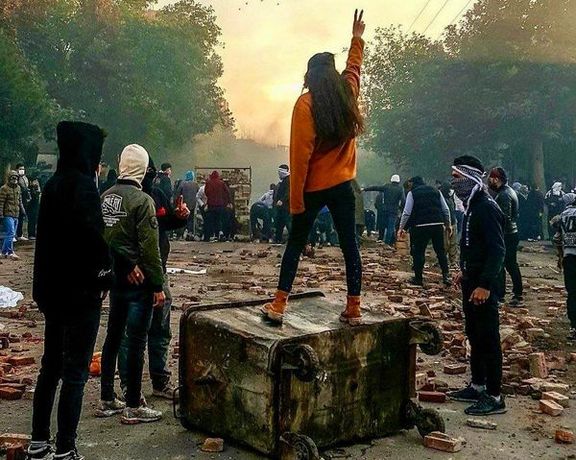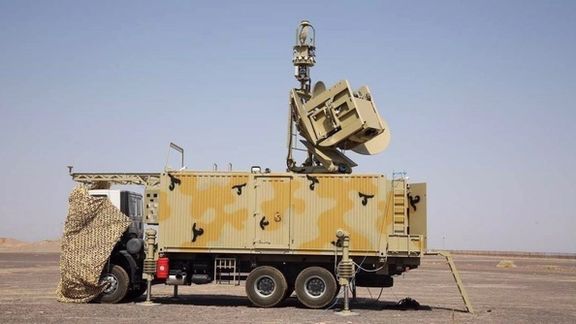Iran Demands $330 Million From US For 1980 Coup Plot

Iran's Judiciary has called on the US government to pay $330 million in compensation for its alleged role in the Nojeh coup plot against Iran's regime in July 1980.

Iran's Judiciary has called on the US government to pay $330 million in compensation for its alleged role in the Nojeh coup plot against Iran's regime in July 1980.
Widely referred to as the Nojeh Coup, the Saving Iran's Great Uprising was a scheme aimed at toppling the recently formed clerical regime Iran, along with its leadership under President Abolhassan Banisadr and Ruhollah Khomeini.
The plot, which was never executed, involved officers of Iran's royal army and civilians opposed to the Islamic Republic. This is the first time that the Iranian regime is accusing the United States of involvement in the plot.
According to the court verdict, the US government has been sentenced to pay $30 million for material and moral damages to the plaintiffs and $300 million for punitive damages.
The judiciary media center announced Saturday that “an open court session was held last month to address the claims of the families of the victims of the coup incident. The session took place at a judicial complex in Tehran, with the presence of survivors and those affected by the incident.”
The coup plot involved personnel from infantry, air force, army, and secret service of the Shah. It was largely foiled by the arrest of numerous officers on July 9-10, 1980, at Nojeh Air Base near Hamedan, west of Iran.
The demand from the Iranian regime comes in the wake of a deal with the Biden administration earlier this month to unblock $6 billion of Iran's frozen funds in exchange for five US citizens held hostage by Iran.
While Khomeini ordered the execution of those involved, Banisadr employed legal tactics to postpone the executions. With the Iraq invasion, many were released under the pledge of returning to duty. Nonetheless, 144 participants were executed, and 2,000–4,000 military personnel were dismissed.

US envoy for Iran met Friday with the family of US permanent resident Jamshid Sharmahd, who was left out of a prisoner release deal with Tehran earlier this month.
Sharmahd, a German Iranian citizen who was kidnapped in Dubai by Iranian agents in 2020 and taken to Iran possibly through Oman, was sentenced to death in February in Iran after being convicted of heading a pro-monarchist group accused of a deadly 2008 bombing.
Deputy Special Envoy Abram Paley posted a picture of himself with Sharmahd's son Shayan and daughter Gazelle on the social media site X, formerly known as Twitter.
"I welcomed the opportunity to meet with Jamshid Sharmahd’s family today. He should have never been detained in Iran, and we hope to see the day he is reunited with his loved ones," Paley wrote.
Paley has taken over the position of US envoy for Iran after Rob Malley who was appointed to the post at the beginning of the Biden administration was put on unpaid leave in June after an apparent violation of security protocols. The Federal Bureau of Investigation is handling his case.
Responding to the post, Gazelle Sharmahd said she had told Paley she needed "actions" and that her father must be part of whatever is agreed to free US nationals.
"We will continue to urge the Biden Administration to work with stakeholders to #LeaveNoOneBehind or stop negotiations with my dad’s kidnappers," Sharmahd said on X.
Gazelle and Shayan have been camping outside the State Department for over a week, demanding a meeting with US officials to press their father’s case. Diaspora Iranians have expressed a wave of support on social media for the Shahmahd family and many Iranian Americans have visited the daughter and son outside the State Department. Iran’s exiled Prince Reza Pahlavi visited them last week and voiced his support for their case.
A deal to free five US citizens taken hostage by Iran in exchange for freeing $6 billion of Iranian funds frozen in South Korea, has led to intense controversy, especially that two more prisoners were not included in the deal. Former American and Australian hostages in Iran have criticized the Biden administrations for what is seen as essentially a ransom payment to Iran, arguing that it will further encourage hostage taking by bad actors.
Since his imprisonment, human rights organizations have warned of 68-year-old Sharmahd’s deteriorating health. He has been held in solitary confinement and was denied an independent attorney and fair legal procedures during his trial. In February, Iran's judiciary sentenced him to death.
Iran's intelligence ministry at the time when Shahrmahd was kidnapped and taken to Iran, described him as "the ringleader of the terrorist Tondar group, who directed armed and terrorist acts in Iran from America."
Based in Los Angeles, the little-known Kingdom Assembly of Iran, or Tondar, says it seeks to restore the Iranian monarchy that was overthrown by the 1979 Islamic revolution. It runs pro-Iranian opposition radio and television stations abroad.

Iranian media have announced the commencement of an electronic warfare exercise held within the country's central regions to counter drone attacks.
According to a report by local media on Friday, the joint electronic warfare exercise was initiated by the Islamic Republic Army. The exercise involves practical evaluation and training of various stationary, mobile, ground-based, and aerial electronic warfare systems.
Units from the Navy, Ground Forces, Air Force, as well as air defense participated in this exercise, which took place primarily in a desert region.
The IRIB news agency wrote, "Electronic defense systems stationed in the exercise area successfully executed non-lethal defense operations and electronic protection against unmanned aerial vehicles and small attacking drones."
A day before this exercise, Habibollah Sayyari, the Deputy Coordinator of the Army, stated, "Given the importance of electronic warfare in today's battles and its significant role in future conflicts, special attention to electronic warfare technologies… have been on the agenda of the Islamic Republic of Iran Army in recent years."
This exercise takes place at a time when Iran's nuclear sites located in central areas of the country have been targeted by drone attacks in the past years.
In February, The Wall Street Journal, in an exclusive report quoting American officials and individuals, attributed a drone attack on a defense ministry complex in Esfahan to Israel.
While the Islamic Republic has been supplying drones to Russia for use in attacks on Ukraine, the spokesperson of the Ukrainian Air Force also declared at that time that the drone attack on military installations in Esfahan was a consequence of the policies of the Islamic Republic.

Russia's military cooperation with Iran will not succumb to geopolitical pressure, Russian Deputy Foreign Minister Sergei Ryabkov said, referring to pressure from the United States.
Washington has been publicly demanding that Iran should stop providing military drones to Russia and scale down its bilateral military cooperation.
"There are no changes, and cooperation with Iran will continue," Ryabkov said, according to a report on Saturday from Russian state news agency RIA. "We are independent states and do not succumb to the dictates of the United States and its satellites."
The US is pressing Iran to stop selling the armed drones, which Russia is using in the war in Ukraine, the Financial Times reported earlier this month, citing an Iranian official and another person familiar with the talks.
Russia began using the Iranian-made Shahed drones to attack deep inside Ukraine last year. The so-called kamikaze unmanned drones do not need a runway to launch and explode on impact. Ukraine has learned to shoot down most of the unmanned aerial vehicles but Russia has been using them in conjunction with ballistic and cruise missiles to overwhelm Ukraine’s air defenses.
Iran has acknowledged sending drones to Russia but said in the past they were sent before Russia's February 2022 invasion in Ukraine. Moscow has denied its forces used Iranian drones in Ukraine.
However, Russia has used hundreds of the Iranian drones and Ukraine has reported regular deliveries reaching Russia.
A White House official said in June that Iran had transferred several hundred drones to Russia since August 2022.

Iran succeeded in freeing its blocked funds without the revival of the JCPOA nuclear accord, Tehran’s chief negotiator Ali Bagheri-Kani told the state television.
The United States was insisting all along during nuclear talks that Iran’s funds would be released only after a nuclear deal was reached, Bagheri-Kani said during a television interview Thursday evening. However, “Iran’s diplomacy shaped conditions in such a way that the Americans were forced to retreat from their position and free Iran’s funds outside the framework of a [nuclear] agreement.”
Earlier this month, Iran and the United States announced that $6 billion frozen in South Korea due to US sanction will be released through Qatari mediation, as Iran moved five US hostages from prison into home detention. The Iranians insist that the US citizens will be released only as a prisoner exchange deal, and the release of the funds from South Korea is not related to the hostage deal. However, it is clear that the hostages are being kept in Tehran until the money reaches Iranian bank accounts in Qatar. Currently, the funds are with the Swiss central bank, which is exchanging them into euros gradually and will transfer to Qatar.
Bagheri-Kani confirmed that talks over the hostages were taking place alongside nuclear negotiations in 2021-2022, but the process ended when Russia invaded Ukraine in February 2022 and the delegations left Vienna after almost a year of periodic meetings.
He added that Iran continued pursuing the issue of the blocked funds through intermediaries and the US was resisting. In September 2022, however, “Americans accepted to take steps for releasing the money outside the framework of the nuclear talks, after our persistent follow-ups.”

This coincides with the start of nationwide antiregime protests in Iran immediately after the hijab police fatally wounded Mahsa Amini, a 22-year-old woman in mid-September. Once the protests began, the Biden administrations began voicing support for the Iranian people and their human rights. But if we believe the senior Iranian diplomat, this was the time the US administration agreed to discuss the release of the funds.
In early October, the State Department announced that the US was no longer pursuing the revival of the JCPOA.
“Our focus is not an accord that isn’t moving forward, but what is happening in Iran ... this popular movement and the brutal crackdown of the regime against protesters,” US special envoy Rob Malley said in Paris on October 14.“It’s the sale of armed drones by Iran to Russia ... and the liberation of our hostages…”
Two day later, Malley told CNN that "Right now the talks on revival of JCPOA are not on the US agenda; the focus is on what's happening in Iran as the talks are stalled," adding that “Iran has taken a position in those talks for the past two months, which is simply inconsistent with a return to the deal.” The same message was reiterated several times by Secretary of State Antony Blinken and other top officials.
Iranian protesters and their supporters in the US, Europe and elsewhere took these remarks as indication that the Biden administration had given up dealing with Tehran, while Bagheri-Kani’s remarks indicate behind the scenes talks were taking place for the release of the funds.
Bagheri-Kani said in his interview that the protests in Iran briefly “distracted” the Biden administration, “but they quickly returned to the talks at the end of autumn.”
Critics see the hostage deal as a dangerous step by the US, which will embolden Tehran to detain more Americans given the chance and the money can empower it to undertake anti-West actions.
Moreover, media reports have hinted that the administration has in fact reached a wider, unwritten deal with Tehran, because around $3 billion was also released from Iraq. Supposedly, Iran has agreed to marginally slow down its uranium enrichment in exchange for the funds and a US willingness not to actively enforce existing sanctions.

Iran on Friday launched exercises to test its “electronic warfare” capabilities against mock enemy drones, fighter jets and helicopters.
The electronic warfare drills -- codenamed Separ-e Hafezan-e Velayat 1402 (Shield of Velayat's Guardians 1402) -- involved various units from the military's navy, ground and air forces as well as air defenses and was staged in the central, largely desert region of the country.
The state broadcaster said that the exercises featured domestically manufactured radars, drones, manned and unmanned fighter jets, micro aerial vehicles and other military equipment as the country seeks to assess the performance and effectiveness of various fixed, mobile, ground-based and airborne electronic warfare systems.
“The army has the appropriate infrastructure, and we have achieved favorable results in countering threats in today’s world and predicting future threats in this sensitive and complicated arena,” said Rear Admiral Habibollah Sayyari, the deputy chief of the army’s coordination department.

According to Friday's statement by the Army, various tactics and operations have been carried out during the drill, including identifying radio and data link communications, execution of group attack operations by micro aerial vehicles (MAVs) against targets, electronic operations to protect radars, and ground-based electronic operations to disrupt and deceive enemy radar systems.
Iran has recently unveiled a series of what it called new maritime weapons and an upgraded drone earlier this month as Washington appeared to be increasing pressure on Tehran.
Earlier in the month, the Biden administration signaled that it may soon offer to put armed sailors and Marines on commercial ships traveling through the Strait of Hormuz.
The Pentagon last month had already sent additional F-35 and F-16 fighter jets along with a warship to the Middle East in a bid to monitor key waterways in the region following Iran's seizure and harassment of commercial vessels.






